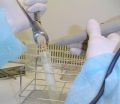(Press-News.org) This news release is available in German.
Researchers of the Max Planck Institute of Molecular Cell Biology and Genetics in Dresden report how they managed to capture detailed three-dimensional images of cardiac dynamics in zebrafish. The novel approach: They combine high-speed Selective Plane Illumination Microscopy (SPIM) and clever image processing to reconstruct multi-view movie stacks of the beating heart. Furthermore, they have developed a method of generating high-resolution static reconstructions of the zebrafish's heart: the Dresden research team used optogenetics to stop the beating heart by illuminating it with light.
Non-periodic phenomena such as irregularly beating hearts and the flow of blood cells are resolved by high-speed volume scanning using a liquid lens. This work is set to be key in our understanding of congenital heart defects as well in future experiments on cardiac function and development. Until recently, available microscopes were too slow to capture a beating heart in 3D. Now, the team led by research group leader Jan Huisken at the Max Planck Institute of Molecular Cell Biology and Genetics has developed a high-speed, selective plane illumination microscope that manages to do just that. By gently illuminating the fish heart with a thin light sheet and observing the emitted fluorescence with a fast and sensitive camera the researchers have achieved fast, non-invasive imaging of labelled heart tissue. The process involves taking multiple movies, each covering individual planes of the heart (movie stacks), then using the correlations between the individual planes to generate a synchronised, dynamic 3D image of the beating heart.
The team also obtained static high-resolution reconstructions by briefly stopping the heart with optogenetics. This procedure does not harm the fish - zebrafish embryos can survive a cardiac arrest of several hours. "These renderings allow us to further follow characteristic structures of the heart throughout the cardiac cycle," says Michaela Mickoleit, PhD student who performed the experiments in Huisken's lab. For instance, they now can clearly observe cardiac contractions or the distance between endo- and myocardium throughout the heartbeat.
By manipulating the exposure time and magnification of the images, better resolution could be achieved and fine details such as sarcomeres and filamentous actin could also be resolved. Finally, they then also went on to resolve non-periodic phenomena by high-speed volume scanning with a liquid lens. For the first time, it has become possible to also image diseased hearts that exhibit arrhythmia – exciting news for cardiologists.
The team at the Max Planck Institute of Molecular Cell Biology and Genetics has developed a fantastic array of tools to image the heart in vivo, ranging from static to ultra-high-speed images. Their work offers potentially revolutionary insights into the cellular structure of the beating heart and are set to further improve our knowledge of congenital heart defects.
INFORMATION:
Original Paper
M. Mickoleit, B. Schmid, M. Weber, F.O. Fahrbach, S. Hombach, S. Reischauer, J. Huisken
High-resolution reconstruction of the beating zebrafish heart
Nature Methods, 20 July 2014.
Unbreak my heart
Max Planck scientists image a beating heart in 3D
2014-07-23
ELSE PRESS RELEASES FROM THIS DATE:
Australian researchers pioneer a 'Google street view' of galaxies
2014-07-23
A new home-grown instrument based on bundles of optical fibres is giving Australian astronomers the first 'Google street view' of the cosmos — incredibly detailed views of huge numbers of galaxies.
Developed by researchers at the University of Sydney and the Australian Astronomical Observatory, the optical-fibre bundles can sample the light from up to 60 parts of a galaxy, for a dozen galaxies at a time.
By analysing the light's spectrum astronomers can learn how gas and stars move within each galaxy, where the young stars are forming and where the old stars live. This ...
K computer runs largest ever ensemble simulation of global weather
2014-07-23
Ensemble forecasting is a key part of weather forecasting today. Computers typically run multiple simulations, called ensembles, using slightly different initial conditions or assumptions, and then analyze them together to try to improve forecasts. Now, using Japan's flagship 10-petaFLOPS K computer, researchers from the RIKEN Advanced Institute for Computational Science (AICS) have succeeded in running 10,240 parallel simulations of global weather, the largest number ever performed, using data assimilation to reduce the range of uncertainties.
The assimilation of the ...
Physical work environment in hospitals affects nurses' job satisfaction
2014-07-23
Job satisfaction is an important predictor of registered nurses' (RNs) job turnover, patient satisfaction, and nurse-sensitive patient outcomes (including pressure ulcers and falls), which can result in higher health care costs and penalties for hospitals that receive Medicare and Medicaid payments. Numerous studies have been conducted to assess nurses' job satisfaction, asking about nurse-physician relationships, opportunities for promotion, autonomy, and similar issues, but very few have addressed the impact of the physical work environment on RNs' job satisfaction.
Now, ...
Minimizing drag to maximize results
2014-07-23
One of the most exciting parts of the Tour de France for spectators is the tactical vying for spots in the breakaway group at the front of the pack.
In trying to better understand the aerodynamic interactions between cyclists, researchers from Monash University and the Australian Institute of Sport studied how riders' drag was affected by the relative position of multiple cyclists (in a formation).
Nathan Barry, a PhD student from the Department of Mechanical and Aerospace Engineering, said the research, undertaken by the Monash Wind Tunnel Sports Group, was designed ...
MIPT-based researcher models Titan's atmosphere
2014-07-23
A researcher from Moscow Institute of Physics and Technology, Prof. Vladimir Krasnopolsky, who heads the Laboratory of High Resolution Infrared Spectroscopy of Planetary Atmospheres, has published the results of the comparison of his model of Titan's atmosphere with the latest data.
The article in the journal Icarus compares the chemical composition of Titan's atmosphere with parameters predicted by a mathematical model. The atmosphere of Saturn's largest moon was described by a model that took into account the presence of 83 neutral molecules and33 ions and420 different ...
Vanderbilt-led study identifies genes linked to breast cancer in East Asian women
2014-07-23
A new study in East Asian women has identified three genetic changes linked to an increased risk of breast cancer. The research, led by Vanderbilt University investigators, was published online July 20 in Nature Genetics.
While breast cancer is one of the most common malignancies among women worldwide, most studies of the genetic risk factors for the disease have focused on women of European ancestry.
Given the differences in genetic heritage and environmental exposures between East Asian women and those of European ancestry, the investigators decided to conduct a study ...
Scientists find way to maintain quantum entanglement in amplified signals
2014-07-23
Physicists Sergei Filippov (MIPT and Russian Quantum Center at Skolkovo) and Mario Ziman (Masaryk University in Brno, Czech Republic, and the Institute of Physics in Bratislava, Slovakia) have found a way to preserve quantum entanglement of particles passing through an amplifier and, conversely, when transmitting a signal over long distances. Details are provided in an article published in the journal Physical Review A (see preprint).
Quantum entangled particles are considered to be the basis of several promising technologies, including quantum computers and communication ...
Obesity linked to low endurance, increased fatigue in the workplace
2014-07-23
FALLS CHURCH, Va. -- U.S. workplaces may need to consider innovative methods to prevent fatigue from developing in employees who are obese. Based on results from a new study published in the Journal of Occupational and Environmental Hygiene (JOEH), workers who are obese may have significantly shorter endurance times when performing workplace tasks, compared with their non-obese counterparts.
The study, conducted at Virginia Tech in Blacksburg, Va., examined the endurance of 32 individuals in four categories (non-obese young, obese young, non-obese older, and obese older) ...
The electric slide dance of DNA knots
2014-07-23
DNA has the nasty habit of getting tangled and forming knots. Scientists study these knots to understand their function and learn how to disentangle them (e.g. useful for gene sequencing techniques). Cristian Micheletti, professor at the International School for Advanced Studies (SISSA) in Trieste and his team have been carrying out research in which they simulate these knots and their dynamics. In their latest paper, just published in the journal Soft Matter, Micheletti together with Marco Di Stefano, first author and PhD student at SISSA, and colleagues from Ljubljana ...
Ancient genetic material from caries bacterium obtained for the first time
2014-07-23
Streptococcus mutans, one of the principal bacteria that cause dental caries, has increased the change in its genetic material over time, possibly coinciding with dietary change linked to the expansion of humanity. This is highlighted in a study by researchers from the Universitat Autònoma de Barcelona (UAB) and the Laboratorio Nacional de Genómica para la Biodiversidad (National Laboratory of Genomics for Biodiversity) in Mexico who, for the first time, have sequenced genetic material from this bacterium in populations from the past. Increase in genetic diversity has ...
LAST 30 PRESS RELEASES:
New compound from blessed thistle promotes functional nerve regeneration
Auburn’s McCrary Institute, ORNL to partner on first regional cybersecurity center to protect the nation’s electricity grid
New UNC-Chapel Hill study examines the increased adoption of they/them pronouns
Groundbreaking study reveals potential diagnostic marker for multiple sclerosis years before symptom onset
Annals of Internal Medicine presents breaking scientific news at ACP’s Internal Medicine Meeting 2024
Scientists discover new way to extract cosmological information from galaxy surveys
Shoe technology reduces risk of diabetic foot ulcers
URI-led team finds direct evidence of ‘itinerant breeding’ in East Coast shorebird species
Wayne State researcher aims to improve coding peer review practices
Researchers develop a new way to safely boost immune cells to fight cancer
Compact quantum light processing
Toxic chemicals from microplastics can be absorbed through skin
New research defines specific genomic changes associated with the transmissibility of the monkeypox virus
Registration of biological pest control products exceeds that of agrochemicals in Brazil
How reflecting on gratitude received from family can make you a better leader
Wearable technology assesses surgeons’ posture during surgery
AATS and CRF® partner on New York Valves: The structural heart summit
Postpartum breast cancer and survival in women with germline BRCA pathogenic variants
Self-administered acupressure for probable knee osteoarthritis in middle-aged and older adults
2024 Communicator Award goes to “Cyber and the City” research team based in Tübingen
A new therapeutic target for traumatic brain injury
Cosmic rays streamed through Earth’s atmosphere 41,000 years ago
ACP issues clinical recommendations for newer diabetes treatments
New insights into the connections between alcohol consumption and aggressive liver cancer
Unraveling water mysteries beyond Earth
Signs of multiple sclerosis show up in blood years before symptoms
Ghost particle on the scales
Light show in living cells
Climate change will increase value of residential rooftop solar panels across US, study shows
Could the liver hold the key to better cancer treatments?
[Press-News.org] Unbreak my heartMax Planck scientists image a beating heart in 3D




